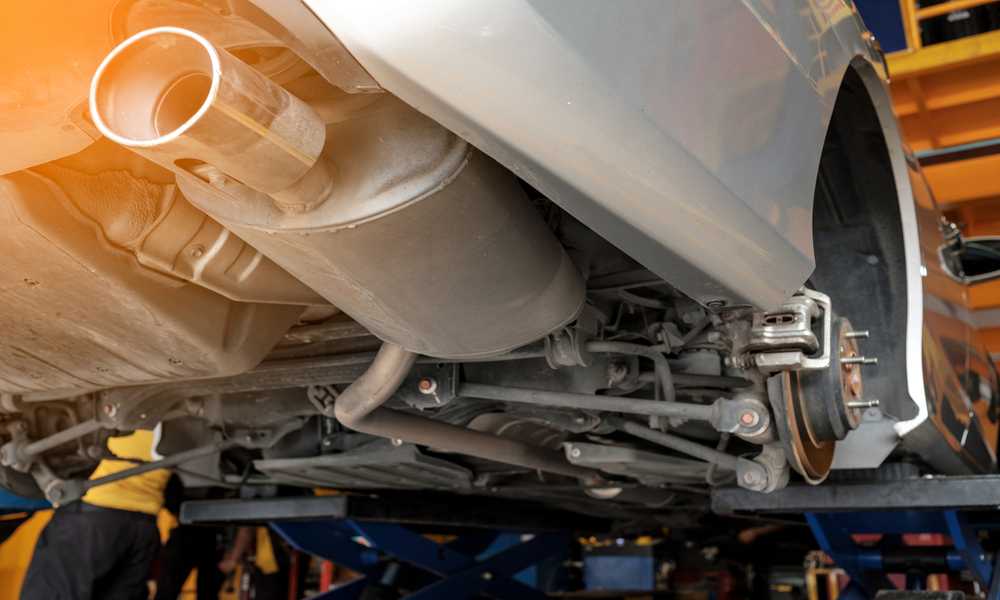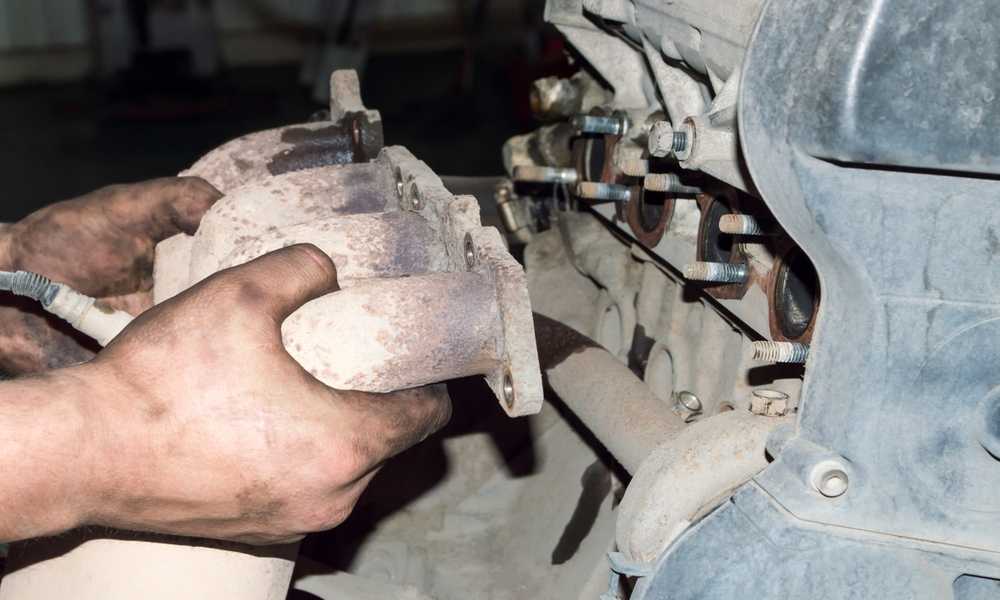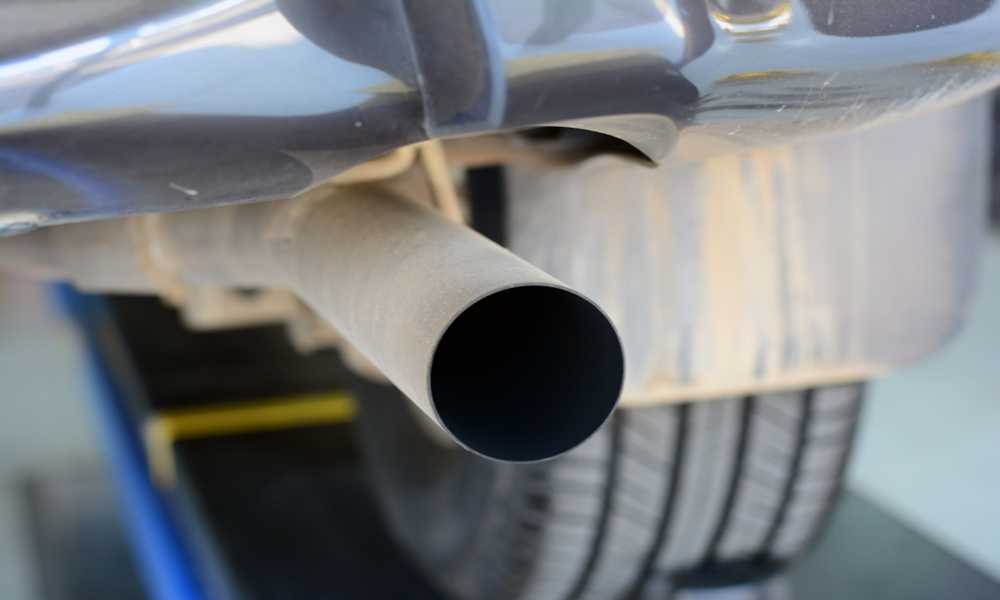Have you ever heard a loud exhaust noise coming from your car? Or have you felt vibrations in the steering wheel or gas pedal while driving? These could be signs of an exhaust leak, which can cause various issues to your vehicle. An exhaust system is vital for your engine’s performance and safety, so it’s crucial to understand what can an exhaust leak cause and how to fix it. In this blog post, we’ll discuss five possible causes of an exhaust leak, as well as tips for finding and fixing them. So buckle up and let’s dive into the world of automotive maintenance!
Possible causes of an exhaust leak
There are several possible causes of an exhaust leak, and understanding them can help you identify the issue with your vehicle. One common cause is corrosion on the exhaust system components, which can weaken or break down over time. This is especially true in areas where road salt or other chemicals are used to melt ice and snow.
Physical impacts can also cause damage to the exhaust system, such as hitting a curb or driving over rough terrain. The force of impact can dent or crack the pipes, leading to leaks.
Failing gaskets are another potential culprit for an exhaust leak. Gaskets seal the connections between different parts of the exhaust system, but they can wear out over time due to heat exposure and vibrations from normal driving.
Poor welds during installation or repairs may also be responsible for causing an exhaust leak. If a weld isn’t done correctly, it could create gaps that allow fumes to escape.
Even age itself can play a role in causing an exhaust leak. Over time, materials degrade and weaken; this is why regular maintenance checks are important for identifying issues before they become more severe.
Knowing these possible causes will help you understand why your car’s performance may have decreased recently – and how best to fix it!
1. Corrosion
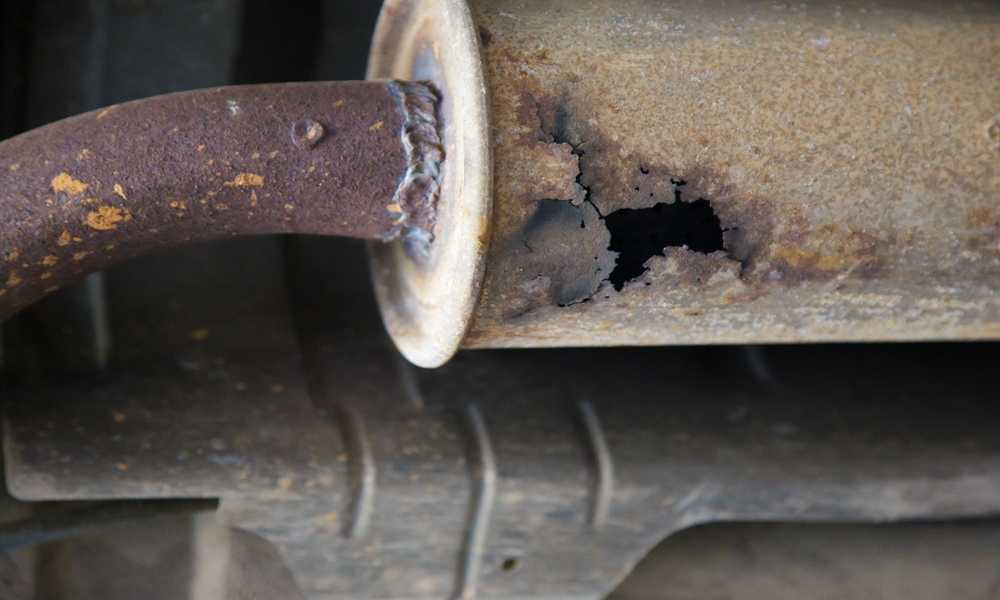
Corrosion is one of the most common causes of an exhaust leak. This happens when moisture and salt from the road mix with hot gases inside your exhaust system, causing rust to form on metal surfaces.
The corrosion process can start small, but over time it can eat away at pipes and mufflers until they develop holes or cracks. The longer you wait to address a corroded exhaust system, the worse the problem will become.
Some people mistakenly believe that only older cars are susceptible to corrosion, but even newer vehicles can be affected by this issue. If you frequently drive in areas with harsh winter weather or salty roads near coastal regions, your vehicle’s exhaust system may be more prone to developing rust and corrosion.
Regular maintenance and inspections of your vehicle’s exhaust system can help catch any potential problems early on before they worsen. In addition, coating metal parts with anti-corrosion products can also help prevent future damage caused by moisture and salt exposure.
2. Physical impacts
Another possible reason for an exhaust leak is physical impacts. This can happen when the exhaust system gets hit by something, either while driving or parked. Even small bumps and collisions can cause damage to the exhaust pipes, muffler, or catalytic converter.
Physical damage may not always be visible to the naked eye. It’s important to look for signs of a leak even if there doesn’t seem to be any noticeable dents or scratches on your car’s undercarriage.
One way to identify this type of leak is through sound. If you hear rattling or unusual noises coming from your car’s underbelly, it could indicate that there has been some sort of physical impact.
It’s also worth noting that off-roading and other activities that involve rough terrain can put additional strain on an already compromised exhaust system.
If you suspect that your car has experienced physical damage leading to an exhaust leak, it’s best to take it into a reputable mechanic who can assess the situation and recommend repairs as needed.
3. Failing gaskets
Failing gaskets are one of the most common causes of exhaust leaks. Gaskets act as seals between different parts of the exhaust system, such as the manifold and the pipes or muffler. Over time, these gaskets can wear out due to heat and normal wear and tear.
When a gasket fails, it can cause an exhaust leak that allows toxic fumes to enter your car’s cabin. These fumes can be harmful if inhaled for prolonged periods. Additionally, failing gaskets can cause loud noises coming from underneath your car.
To fix a failing gasket, you’ll need to replace it with a new one made from high-quality materials that will last longer than the previous one. This is not always an easy task since some gaskets may be difficult to reach or require special tools for installation.
Regular maintenance checks on your vehicle’s exhaust system can help prevent failures before they occur. It’s important not to ignore any signs of potential problems like rattling sounds or abnormal vibrations while driving which could indicate a failing gasket or other issues within your vehicle’s exhaust system.
4. Poor welds
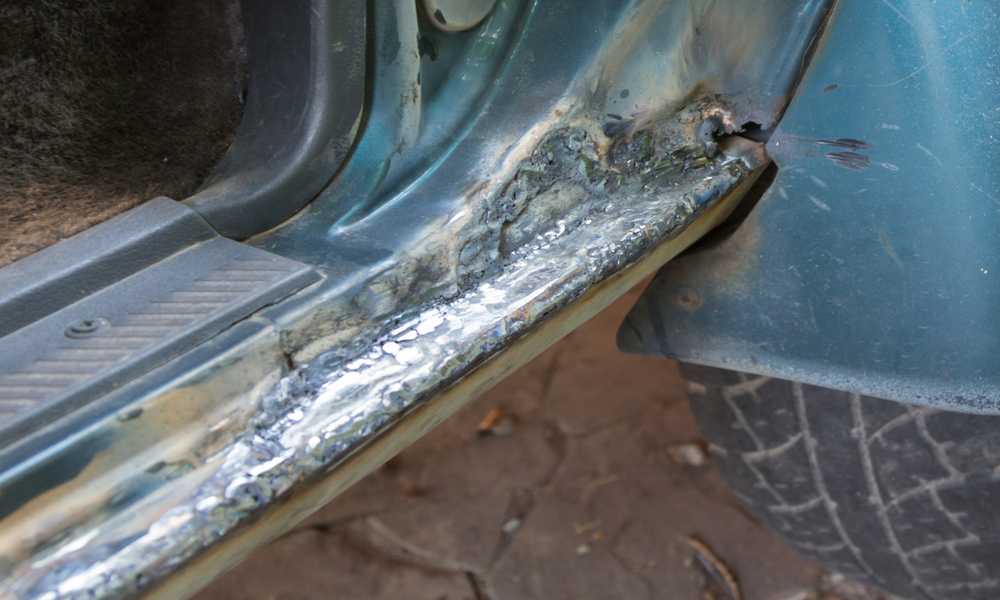
Poor welds are another common cause of exhaust leaks. Welding is the process of joining two pieces of metal together, and poor welding can leave gaps or holes in the exhaust system.
One reason for poor welding could be improper installation or repair work done by an inexperienced mechanic. In some cases, corrosive chemicals used on roads during winter months can also corrode welds over time.
If you suspect a leak caused by poor welding, it’s important to have a professional inspect the exhaust system thoroughly. They may recommend replacing sections with poor welds rather than patching them up.
Preventing future problems with your exhaust system due to poor welds involves finding a reputable mechanic who has experience working with exhaust systems and using high-quality parts to prevent corrosion and damage from wear-and-tear.
If you notice any unusual smells or sounds coming from your car’s engine area, it’s essential to get your vehicle checked out as soon as possible. Poorly welded joints can quickly lead to serious problems that could result in costly repairs down the road.
5. Time and age
One of the most common causes of an exhaust leak is simply time and age. As your vehicle ages, its various components begin to wear down, including the exhaust system.
Over time, exposure to heat and moisture can cause rust and corrosion to form on metal surfaces within the system. This can weaken these components and create holes or cracks where exhaust gases can escape.
In addition, the constant expansion and contraction caused by heating and cooling cycles can put additional stress on gaskets, seals, and other connections in the system. Over time, these parts may start to degrade or fail altogether.
While there’s no way to completely prevent this natural aging process from occurring in your vehicle’s exhaust system, regular maintenance can help prolong its lifespan. Make sure you’re having your vehicle inspected regularly by a qualified mechanic who knows what signs of trouble to look for so that any issues with your exhaust system are caught early before they become major problems.
Fixes for exhaust leaks
If you suspect an exhaust leak, it is crucial to have it fixed as soon as possible. Not only can an exhaust leak cause poor gas mileage and decrease the overall performance of your vehicle, but it can also be a safety hazard due to toxic fumes entering the cabin.
One common fix for small leaks is using a high-temperature sealant or tape made specifically for exhaust systems. However, these are temporary solutions that may not hold up over time.
A more permanent fix involves replacing any damaged components such as gaskets, pipes or mufflers. Depending on the severity of the damage, this can be done at home if you have experience working with cars or by taking your vehicle to a professional mechanic.
Remember that prevention is key in avoiding future leaks. Regular maintenance checks and inspections will help catch any potential issues before they become larger problems.
Fixing an exhaust leak should be taken seriously and addressed promptly to ensure both optimal vehicle performance and driver safety.
What is an exhaust system?
An exhaust system is a vital component of any vehicle. It is responsible for transporting the harmful gases produced during combustion away from the engine and out of the car’s tailpipe. The system comprises several interconnected parts that work together to ensure efficient emission control.
At its core, an exhaust system contains an exhaust manifold, which collects hot gasses from each cylinder head and directs them into a single pipe. This leads to either a catalytic converter or resonator depending on the type of car you have.
The catalytic converter then acts as a filter, turning toxic pollutants like carbon monoxide into less dangerous emissions such as water vapor and carbon dioxide before releasing it through your car’s tailpipe.
A resonator, on the other hand, reduces or eliminates unwanted noise in the exhaust sound waves. From there, this filtered gas passes through various connecting pipes towards mufflers which reduce noise even further by reducing vibrations caused by high-pressure gases passing through pipes with varying diameters.
At the end of your vehicle’s exhaust system lies a tailpipe where clean emissions exit your automobile.
What is an exhaust manifold?
The exhaust manifold is an essential part of the vehicle’s exhaust system that connects the engine to the rest of the system. It is typically made of cast iron or stainless steel and consists of several pipes that merge into one larger pipe.
The primary function of an exhaust manifold is to collect gases from each cylinder and combine them into a single stream before directing them towards other components, such as catalytic converters, resonators, mufflers, and tailpipes. By doing so, it reduces back pressure on the engine and allows for better performance overall.
Exhaust manifolds are designed to withstand high temperatures without warping or cracking. However, they can still become damaged over time due to exposure to heat cycles and corrosive elements in the environment. Common issues include cracked welds or rusted flanges that result in leaks.
It’s important to keep your exhaust manifold well-maintained because any damage can cause serious problems with your vehicle’s performance. If you suspect there may be an issue with your car’s exhaust manifold, have it checked by a professional mechanic right away.
Our tips for finding exhaust leaks
Finding an exhaust leak can be a tricky task, especially if you’re not familiar with your car’s anatomy. Here are some tips to help you locate the source of the problem:
Listen and feel for any unusual noises or vibrations around the exhaust system while the engine is running. This could indicate a possible leak.
Try blocking off the tailpipe with a rag while someone else revs the engine. If there’s pressure building up in the system that escapes through other areas besides the blocked-off pipe, it may mean that there is a leak.
Spray soapy water around suspect areas where leaks may occur. If bubbles appear, then you’ve found your culprit!
Fourthly, use a smoke machine to see where smoke comes out from under your hood when you start up your car.
Try sticking a shop vac into one end of the tailpipe and sealing it tightly with duct tape. Turn on your vacuum cleaner and look for places where air is escaping.
By following these simple tips above for finding exhaust leaks yourself at home before taking them into an auto mechanic or repair shop will save time and money in repairs further down line!
1. Listen and feel
One of the easiest ways to detect an exhaust leak is by listening and feeling for any unusual sounds or vibrations coming from your vehicle. Start by turning on your car and allowing it to idle while parked.
Next, walk around the car and listen carefully for any abnormal noises such as hissing, popping, or ticking sounds that may be emanating from the exhaust system. You can also try touching various parts of the exhaust system with a gloved hand to feel for any unusual vibrations.
If you’re having trouble locating the source of a potential leak, try moving closer towards different parts of the exhaust system like the manifold or tailpipe while repeating these steps until you find where it’s coming from.
Keep in mind that detecting an exhaust leak through this method may not always be accurate since some leaks might only occur when driving at higher speeds. However, it’s still worth trying out before resorting to more complicated methods.
2. Block the exhaust with a rag
One of the ways to find an exhaust leak is by blocking the exhaust with a rag. This method can help you identify if there’s any leakage in your car’s system, and it’s incredibly simple.
To begin, locate the tailpipe and put a tightly-woven rag over it. Make sure that it covers the entire opening so that no air can escape. Once you’ve done this, head back into the driver’s seat and start your engine.
If there is an exhaust leak somewhere in your vehicle, then pressure will build up inside when you block off one end of the system. As a result, air will try to come out from other parts of your car’s pipes or joints. You should be able to hear hissing sounds or feel vibrations coming from where leaks are present.
It’s important to note that blocking off your car’s tailpipe creates backpressure on its own which isn’t good for extended periods as it may harm some components like spark plugs or sensors over time so make sure not to keep doing this test too often.
While blocking off your vehicle’s tailpipe doesn’t guarantee finding all potential leaks but could serve as another way of identifying them quickly without having specialized equipment at hand.
3. Soapy water
One of the easiest ways to detect an exhaust leak is by using soapy water. This method can be done at home and doesn’t require any special tools or equipment.
First, mix soap and water in a spray bottle and shake it well. Then, start the car’s engine and let it run for a few minutes until it reaches its normal operating temperature. Next, turn off the engine and spray the mixture onto the suspected leak area.
If there is a leak present, bubbles will begin to form on that spot. The soap helps create a visible reaction when it comes into contact with escaping exhaust gases.
It’s important to wear gloves while performing this test as hot spots may be difficult to identify without touching them – which could result in burns!
While this method is simple, keep in mind that it only works if you have access to all areas of your car’s exhaust system. It won’t work if there are hard-to-reach places or hidden leaks.
4. Smoke machine
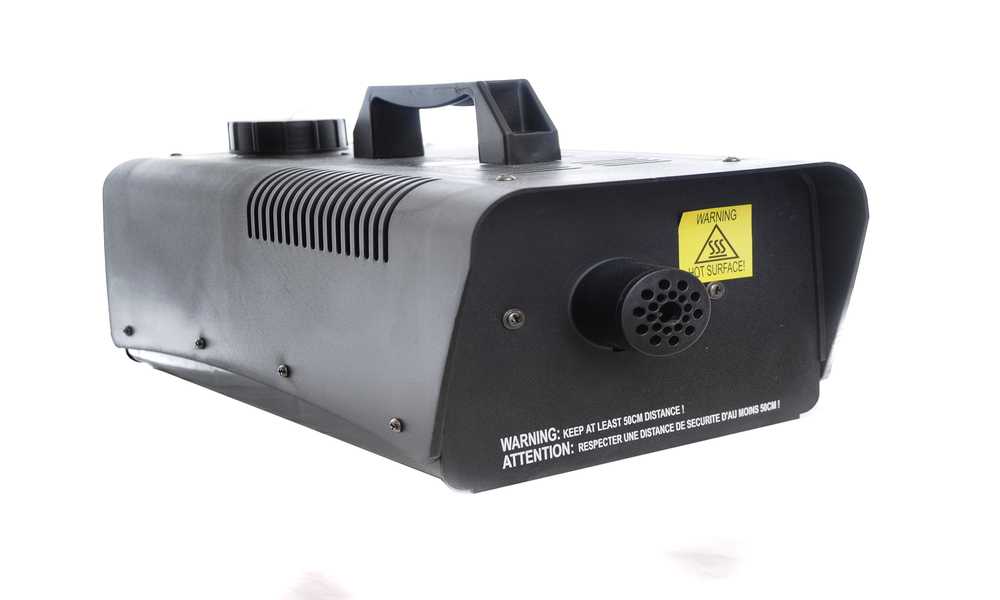
One of the most effective ways to find an exhaust leak is by using a smoke machine. This tool can help detect even the smallest leaks, making it a popular choice among mechanics and DIYers alike.
To use a smoke machine for detecting exhaust leaks, start by plugging any intake ports on the engine with foam or rags. Then connect the output hose from the smoke machine to your tailpipe.
Next, turn on the smoke machine and let it run for several minutes until you see white smoke coming out of any potential leak areas in your exhaust system. The white smoke will make it easy to identify where exactly the leak is occurring.
It’s important to note that while this method is highly effective, it does require some specialized equipment. Smoke machines are not readily available at most auto parts stores and may need to be rented or purchased online.
Using a smoke machine can save you time and effort in finding an exhaust leak. It’s definitely worth considering if you’re serious about fixing your car’s performance issues caused by an exhaust leak.
5. Shop-Vac Into the exhaust pipe
Shop-Vac Into the Exhaust Pipe: A Fix for Stubborn Leaks
When it comes to exhaust leaks, sometimes they can be difficult to find and fix. That’s where a Shop-Vac comes in handy. This method involves using a Shop-Vac to pressurize the exhaust system with smoke or soapy water.
To begin, make sure your car is on level ground and has cooled down completely before inspecting the exhaust system. Once you’ve identified the general area of the leak, insert the hose of your Shop-Vac into the tailpipe and seal it off with duct tape or a rubber stopper.
Next, fill up a container with either soapy water or mineral oil mixed with baby powder. Connect this container to one end of another hose and attach that hose to an opening in your exhaust system – such as an O2 sensor hole or even an unused bung.
Turn on your Shop-Vac and let it run for about five minutes while observing any areas where bubbles appear from escaping air bubbles coming out from gaps between pipes connected by clamps etc.
By using this method you should be able to detect even small leaks that might have been hard-to-find otherwise.
Anatomy of an exhaust system
An exhaust system is an intricate network of pipes that carry the engine’s waste gases away from the vehicle. It consists of several parts, including the exhaust manifold, catalytic converter, resonator, muffler, tailpipe, connecting pipes and O2 sensors.
The exhaust manifold connects directly to the engine block and collects all of its emissions in one place. From there, it channels them through a series of connected pipes called “connecting pipes,” which lead to other components in the system.
At some point along this journey through the connecting pipes lies the catalytic converter – a device designed to reduce harmful pollutants such as carbon monoxide and nitrogen oxide into less harmful gases like water vapor and carbon dioxide.
As gas travels further down toward the rear of your car after passing through other sections like resonators or mufflers setup for different purposes giving rise to deeper tones or quieting down sound levels accordingly before making its final exit out via a tailpipe.
Finally comes O2 sensor(s), detecting oxygen content post-catalytic-converter helping adjust fuel-air ratio for optimal performance while ensuring compliance with emission standards. All these components work together seamlessly to ensure smooth operation and optimal performance from your vehicle’s engine while minimizing pollution output.
1. Exhaust manifold
The exhaust manifold is an essential component of the vehicle’s exhaust system. It is responsible for collecting and expelling exhaust gases from each cylinder into a single pipe. Generally, it is bolted directly to the engine block.
Exhaust manifolds are usually made of cast iron or stainless steel because they need to withstand high temperatures and harsh conditions. The shape of the manifold determines how efficiently it can pull out all those harmful fumes produced by your car’s combustion process.
A cracked or damaged manifold can cause significant problems for your car, leading to decreased performance and fuel economy, as well as more serious issues like carbon monoxide poisoning in extreme cases.
Regular maintenance like inspections will help you detect any cracks early on before they become severe issues. In some cases, a repair may be possible with welding or patching up small holes in the metal. However, if damage is too extensive, replacing the entire manifold might be necessary.
To keep your vehicle running smoothly and safely at all times, always make sure that your exhaust manifold remains in top working condition!
2. Catalytic converter
The catalytic converter is an essential component of the exhaust system that helps to reduce harmful emissions. It contains precious metals like platinum, palladium, and rhodium that promote chemical reactions between the exhaust gases and convert them into less harmful substances.
One of the common problems with a catalytic converter is clogging. Over time, it can get filled with carbon deposits or other contaminants, which can restrict airflow and cause backpressure in the engine. This can lead to poor performance, decreased fuel efficiency, and even damage to other components of the car.
In some cases, a malfunctioning catalytic converter may trigger warning lights on your dashboard. If you notice these signs or suspect there’s something wrong with your vehicle’s emission control system, it’s best to have it inspected by a qualified mechanic.
Regular maintenance of your car’s exhaust system can help prevent issues with the catalytic converter. Some tips include using high-quality fuel additives or cleaners designed for this purpose and following recommended service intervals as outlined in your owner’s manual.
3. Resonator
The resonator is a component in the exhaust system that helps to reduce noise levels. It is essentially a chamber with holes or tubes inside, which creates sound waves that cancel out some of the noise produced by the engine.
Resonators are often used in conjunction with mufflers to further reduce exhaust noise. They work by producing sound waves that are 180 degrees opposite of the ones created by the engine, effectively cancelling them out.
Some vehicles may have multiple resonators installed in their exhaust systems for even greater noise reduction. Resonators can also improve overall performance and fuel efficiency by reducing backpressure in the system.
However, over time, resonators can become damaged or corroded due to exposure to high temperatures and corrosive gases. This can cause them to malfunction or fail completely, leading to increased levels of engine noise and reduced performance.
Regular maintenance and inspection of your vehicle’s exhaust system can help prevent issues with resonators and other components. If you suspect there may be an issue with your car’s exhaust system, it’s important to have it checked out as soon as possible by a qualified mechanic.
4. Muffler
The muffler is an essential component of the exhaust system that helps to reduce the noise produced by the engine. It consists of a metal container that contains several chambers and tubes, which are designed to absorb sound waves.
Inside the muffler, there are baffles or perforated plates that create turbulence in the exhaust gases, breaking up sound waves before they exit through the tailpipe. The closer these baffles or plates are placed together, the more effective they will be at reducing engine noise.
Mufflers can also affect engine performance if they become clogged with debris or rusted out over time. A faulty muffler can cause backpressure in your car’s engine, leading to decreased fuel efficiency and reduced horsepower.
To ensure optimal performance and longevity of your vehicle’s muffler, it is essential to have it inspected regularly by a qualified mechanic. They can identify any issues early on and recommend appropriate solutions like replacing damaged parts or cleaning out accumulated debris for better performance.
Maintaining your car’s muffler is crucial for both its longevity and smooth functioning. Regular checks by a certified professional can help you avoid expensive repairs down the line while ensuring efficient operation of your vehicle’s exhaust system.
5. Tailpipe
The tailpipe is the final component of an exhaust system. It’s where all the gases exit after being processed by the catalytic converter, resonator, and muffler.
Tailpipes come in a variety of shapes and sizes depending on the make and model of your vehicle. Some are straight while others are curved or angled to help direct exhaust away from other components or improve aerodynamics.
In addition to shape, tailpipes can also be made from different materials such as stainless steel or aluminized steel. Stainless steel resists rust and corrosion better than aluminized steel but is more expensive.
Despite their importance in directing exhaust away from the car, tailpipes can often go overlooked when performing routine maintenance checks. However, it’s important to keep them clean since they can accumulate carbon buildup over time which could lead to reduced performance.
If you notice any issues with your tailpipe such as holes or damage, it’s best to have it inspected by a professional mechanic who can determine if repairs or replacement are necessary for safe driving conditions.
6. Connecting pipes
Connecting pipes are a crucial component of an exhaust system. They link together the different parts of the system, including the manifold, catalytic converter and muffler. These pipes must be tightly sealed to prevent any leaks that can cause various issues.
A common problem with connecting pipes is rust and corrosion due to exposure to moisture and chemicals. This can lead to cracks or holes in the pipe, which can cause a decrease in engine performance as well as increased emissions.
Replacing damaged connecting pipes is essential for maintaining your vehicle’s health. A professional mechanic should inspect them regularly during routine maintenance checks to ensure they are functioning correctly.
Moreover, upgrading your factory connecting pipes with high-performance ones can improve exhaust flow and overall engine performance significantly. However, it’s important to note that modifying your exhaust system may not be legal depending on where you live.
Connecting pipes play a vital role in ensuring proper function of an exhaust system by linking its components together securely. Regular inspection and replacement when necessary will help keep you safely on the road while improving your vehicle’s overall health.
7. O2 sensors
O2 sensors are an essential component of modern exhaust systems. These sensors monitor the amount of oxygen in the exhaust gases and communicate that information to the engine control unit (ECU).
The ECU then adjusts various parameters, such as fuel injection timing and air-fuel ratio, to optimize engine performance and reduce emissions.
There are typically one or two O2 sensors located before and after the catalytic converter in a vehicle’s exhaust system.
If there is an issue with these sensors, it can cause problems with how your car runs, including poor gas mileage and increased emissions.
It’s important to keep these sensors clean and free from debris so they can accurately measure oxygen levels in your car’s exhaust.
Regular maintenance checks by a qualified mechanic will ensure proper functioning of O2 sensors. It is also crucial to replace faulty O2 Sensors promptly for better engine health.
It cannot be overstated how critical O2 Sensors are for optimal vehicle performance today; hence owners should make sure this integral part of their automobiles regularly undergoes maintenance checks by competent mechanics for best results.
What can an exhaust leak cause? : Symptoms
Symptoms of an exhaust leak can be dangerous if left unchecked. Here are some indications that your car may have an exhaust leak:
1) Louder-than-normal Exhaust: If your vehicle’s exhaust sounds louder than usual, it could indicate a problem with the system.
2) Buzzing, Hissing, Ticking, Popping or Puffing Noises: Any unusual noise coming from the engine area should alert you to potential issues with your car’s exhaust.
3) Vibrations: If you feel vibrations in the steering wheel or pedals when driving, it could mean there is an issue with the muffler.
4) Worse Gas Mileage: Experiencing lower gas mileage than normal could be due to a damaged catalytic converter caused by an exhaust leak.
5) Exhaust Fumes in Front of Car or Cabin of Car: This is one clear indication that something is wrong. Smelling toxic fumes while driving means you need to take immediate action and get your car checked out.
6) Exterior Carbon Buildup: Black carbon deposits on the exterior body near tailpipes can be another sign of an exhaust leak.
7)Literal holes in Metal- Rusty spots on metal surfaces around components such as manifold where gases flow through can lead to tiny holes forming which will cause leaks
If any of these symptoms sound familiar to you, don’t ignore them! Get your vehicle inspected immediately by a professional mechanic who understands how important having proper functioning parts for safe operation during all seasons is!
1. Louder-than-normal exhaust

One of the most common symptoms of an exhaust leak is a louder-than-normal exhaust sound. This can happen when there’s a hole in the exhaust system, allowing air to escape and creating a louder noise than usual.
It’s important to note that not all loud noises from your car’s exhaust indicate an exhaust leak. Your car may simply be designed with a sportier or more aggressive sounding muffler or engine. However, if you notice that your car sounds significantly louder than normal, it could be due to an exhaust leak.
In addition to being annoyingly loud, driving with an exhaust leak can also be dangerous as it may allow toxic carbon monoxide gas into the cabin of your vehicle. This can lead to symptoms such as headache, nausea, dizziness and even unconsciousness.
If you suspect that your car has an exhaust leak causing excessive noise levels, make sure to have it inspected by a mechanic as soon as possible before any further damage occurs or health risks arise.
2. Buzzing, hissing, ticking, popping, puffing noises
One of the most obvious symptoms of an exhaust leak is unusual noises coming from your vehicle. These sounds may include buzzing, hissing, ticking, popping and puffing. They can occur at different points in the exhaust system and can vary depending on the severity of the leak.
If you hear a buzzing or hissing sound when driving your car, it could be a sign that there’s an exhaust leak near the engine. This type of noise typically occurs when there’s a hole in the manifold or gasket. It’s important to address this issue as soon as possible because it can lead to increased emissions and decreased fuel efficiency.
Ticking and popping noises usually occur further down in the exhaust system around mid-pipe or muffler area. These sounds are often caused by holes or cracks in these components due to rust damage or physical impacts like hitting speed bumps too hard.
Puffing sounds might indicate that there is a hole somewhere at your tailpipe exit point while tapping footnotes might mean bad seals between muffler pipes.
Regardless of what kind of strange noise you’re hearing from your car’s exhaust system, it’s important not to ignore them if they persist after normal conditions have been restored such as temperature change etc., otherwise more severe problems could arise over time leading to potentially costly repairs later on down line
3. Vibrations
One of the possible symptoms of an exhaust leak is vibrations. If you notice that your car is vibrating more than usual, it could be a sign that there’s a problem with your exhaust system. These vibrations can occur for several reasons.
If there’s a hole in your exhaust pipe or muffler, it can cause the gases to escape unevenly and disrupt the airflow through the system. This disruption can create vibration as pressure builds up and tries to escape.
If one part of your exhaust system isn’t attached properly or has become disconnected due to corrosion or physical impact, it can also cause vibrations. The loose part will vibrate against other parts of the vehicle and create an annoying humming sensation.
Worn-out engine mounts could also be responsible for these vibrations as they may not be able to keep the engine steady during acceleration when coupled with increased sound from leaking exhaust systems.
If you’re experiencing any unusual vibrations while driving, don’t ignore them! They could indicate something serious going on under your hood – like an issue with your suspension or even brake rotors – which requires immediate attention from a professional mechanic.
4. Worse gas mileage
One of the most frustrating symptoms of an exhaust leak is a decrease in gas mileage. When your car’s exhaust system isn’t working properly, it can cause your engine to work harder than it needs to, leading to wasted fuel and decreased efficiency.
If you’ve noticed that you’re filling up at the gas station more often than usual, it could be a sign that there’s an exhaust leak somewhere in your car. This issue not only wastes fuel but also costs you more money over time.
In addition to causing a decrease in gas mileage, an exhaust leak can also lead to other issues such as damage to your catalytic converter and O2 sensors. These components are important for reducing emissions and ensuring proper engine performance.
It’s essential to have any suspected leaks checked out by a professional mechanic right away before they cause further damage or become safety hazards on the road. So if you notice anything unusual with your car’s performance or gas usage, don’t hesitate – get it looked at ASAP!
5. Exhaust fumes in front of car or cabin of car
One of the most concerning symptoms of an exhaust leak is when fumes start entering the cabin or being emitted from the front of your car. This can be extremely dangerous, as inhaling these fumes can cause carbon monoxide poisoning, which can lead to headaches, nausea and even death.
The reason why this happens is because an exhaust leak allows toxic gases to bypass the catalytic converter and enter into areas they shouldn’t be in. These gases are hazardous to humans and animals alike.
If you notice exhaust fumes anywhere near your vehicle’s interior or around its engine compartment, it’s important to get it checked out immediately by a mechanic who specializes in automotive exhaust systems. They will be able to diagnose any leaks quickly and efficiently before any serious harm occurs.
Remember that prevention is always better than cure: regular maintenance checks on your car’s muffler system can prevent potentially fatal accidents from happening due to carbon monoxide poisoning caused by exhaust leaks.
6. Exterior carbon buildup
One of the symptoms of an exhaust leak is exterior carbon buildup. This occurs when there is a hole or gap in the exhaust system that causes air to escape before it reaches the end of the tailpipe.
As hot exhaust gases exit the engine, they mix with oxygen and other elements in the atmosphere. When there’s a leak, those gases can’t travel through their intended path, so they’re released into the outside environment instead.
The result is usually a dark, powdery substance on and around your tailpipe that looks like carbon build-up. It may be accompanied by black smoke coming out of your car’s exhaust pipe as well.
Not only does this look unsightly, but it can also cause damage to your car’s paint job over time if it isn’t cleaned off regularly.
If you notice exterior carbon buildup on your vehicle’s tailpipe or surrounding areas, consider having a mechanic inspect your exhaust system for leaks as soon as possible.
7. Literal holes in the metal
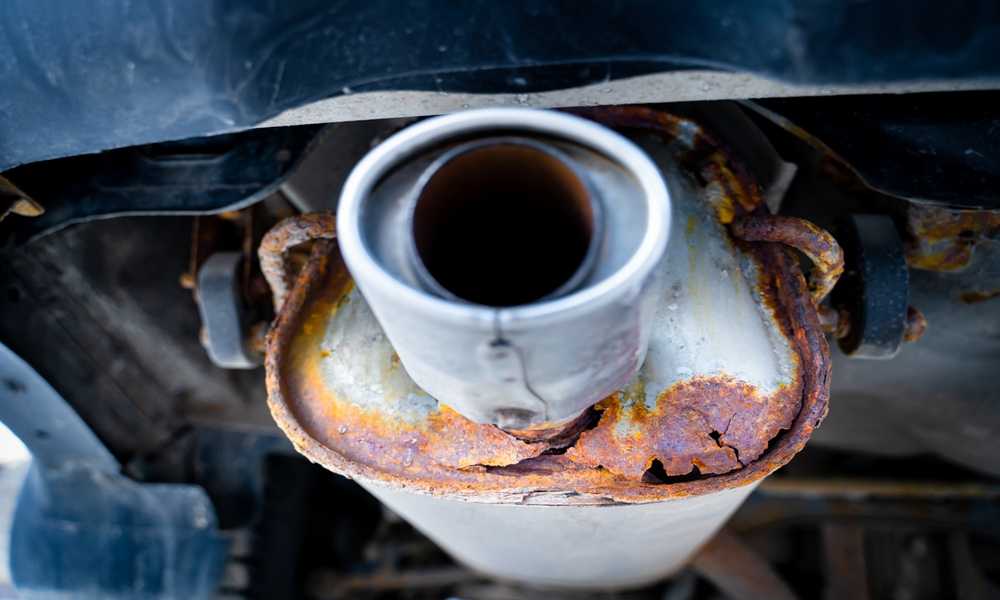
Literal holes in the metal of your exhaust system can be a sign of a severe exhaust leak that requires immediate attention. These holes can occur for various reasons, including corrosion caused by salt and moisture on roads, physical damage from rocks or debris hitting the underside of your car, or simply due to wear and tear over time.
When literal holes appear in your exhaust system’s metal pipes or muffler, it allows harmful carbon monoxide gas to escape directly into the environment rather than being carried away through the tailpipe. This not only poses a danger to you and your passengers but also contributes to air pollution.
Moreover, having literal holes in your exhaust system can negatively impact engine performance, leading to reduced fuel efficiency and power output. It is crucial to take action as soon as possible if you notice any signs of literal holes in the metal components of your vehicle’s exhaust system.
If you suspect that there may be literal holes present in your vehicle’s exhaust system, have it inspected by a professional mechanic immediately before further harm is done.
Final thoughts
It is important to take any signs of an exhaust leak seriously. Not only can they affect the performance and fuel efficiency of your vehicle, but they can also pose a serious safety risk. By understanding the possible causes and fixes for exhaust leaks, as well as being aware of the symptoms, you can keep your car running smoothly and safely.
Regular maintenance checks are crucial in preventing exhaust leaks from occurring in the first place. It’s always better to catch a potential problem early rather than waiting until it becomes a bigger issue.
Remember: if you suspect that you have an exhaust leak, it’s best to have your vehicle inspected by a professional mechanic immediately. With proper care and attention, you can prevent any major issues arising from an exhaust leak!
